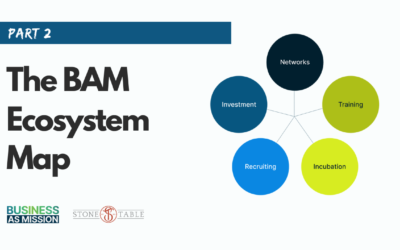Virtual Connections Will Never Replace the Power of Being Physically Present with Other People

A few years back I spent three days in Djibouti. Outside of the non-stop jokes that the pronunciation of this country’s name produces (they just write themselves, folks), our time on the Horn of Africa also gifted me one of my favorite stories to share over long dinner conversation.
Djibouti City is not exactly a 25th wedding anniversary destination. It’s dry and dusty and not much to look at, but it’s a key port city for Africa and the Middle East, and boasts military bases for some of the world’s most powerful nations. Comfortable hotels aren’t exactly plentiful, so we splurged on the Kempinski, a high-end property used by foreign diplomats that looked like it was right out of an Indiana Jones film. We booked three nights, checked in our bags, and had a beautiful dinner in the lobby overlooking the Gulf of Tadjoura.
The next morning, we hopped in a Land Cruiser and headed north around the Gulf into the mountains and spent the day with the Afar, a warm and welcoming unreached people group that farm goats and live off the land. It was a powerful visit that ended with a meal of goat meat and homemade bread sitting on the dirt floor of one of the tribal leader’s home.
Unfortunately, it also ended too late for us to drive back to our 4-star room at the Kempinski.
An Unfortunate Itinerary Change
The mountain roads in Djibouti become extremely dangerous after dark, so our missionary friends found us a few rooms in Tadjoura on the north side of the Gulf. My room boasted a metal bed frame that held a thin mattress with a small blanket that wouldn’t even cover my feet, and the flickering fluorescent ceiling light revealed all kinds of 6 (and 8) legged friends crawling on the cinder block walls. But to make things even worse, as the sun set over the mountains, I could see the warm, glowing lights of the Kempinski hotel mocking me from across the bay. I had a very expensive room – I could even see it! – but there was no way to get there.
I’m embarrassed to say that I began teetering on the edge of a panic attack. I needed to talk to my wife. Remarkably, this “hotel” had spotty wifi if I stood in the right spot outside on the front porch, so I spent a better part of the night FaceTiming my wife back in the States. It was so comforting to see her face and hear her voice, even when the image froze every few seconds, and ultimately, it helped calm me down and get a few hours of sleep.
Technology was literally bringing us together from the other side of the globe in ways that, just a few years earlier, would have been completely impossible. International travel used to mean being completely out of contact for days at a time. And while I would have much rather been cozied up with my wife in our bug-free Tempurpedic bed, interacting with a digital version of her gave me some genuine peace in a high-anxiety situation. I was grateful.
Digital technology has made it so much easier for me and my family when I travel overseas. Getting frequent texts, sharing pictures, and even live video-chats makes the distance seem smaller and my travels less stressful. I’m grateful for these digital connections, but they’re not as good as the real thing. They’re not anywhere close to the real thing.
A Supplement at Best
Ever since Avatar and The Matrix hit the big screen, this fantasy of replacing the real human world with some kind of virtual version of ourselves has captured the imaginations of more than just the science fiction nerds. We can go to digital places, have digital conversations, and forge digital relationships, right from the comfort of our own smartphones.
This digital universe has added some remarkable real-world value. Because of Facebook, I’ve been able to reconnect with countless old high school friends I would have likely never seen again. Because of Zoom, I’m able to have face-to-face meetings with colleagues who live literally all over the world. And as I’ve already illustrated, because of apps like FaceTime, I can feel closer to my family from a run-down hotel on the Horn of Africa.
But if the coronavirus pandemic has taught me one thing, it’s that this digital world is a supplement at best. It is a nice 21st Century accessory, but it will never be a replacement for real, physical proximity, in-the-same-room human connections. I know there are scientific studies out there that address this, but you don’t need empirical proof, you know this instinctively for yourself.
Digital Church
When COVID shutdown most church gatherings in April and May (still ongoing in some places), pastors scrambled to move their services online. Sanctuaries turned into television production studios piping worship and preaching into their individual members’ living rooms. For two months, my family gathered in our pajamas every Sunday morning around the 42” flatscreen hanging over our fireplace to “worship together” with our church family.
And while it was certainly better than nothing, virtually gathering with God’s people wasn’t any different than listening to a few worship songs on iTunes and catching my favorite preaching podcast. The “Church gathered” is more than 30 minutes of inspiration and information. Church is the connection of people. Real people. Three-dimensional, flesh and blood people. Not screen names in chat rooms.
Online church is a nice supplement, but the gathering of the saints cannot be virtually replicated, at least not permanently. We were made for physical proximity with real people.
Digital School
My daughter was a senior this year (the Class of 2020 will never forget their graduation, that’s for sure). In early January, she was already complaining of senior-itis and dreaming of her next season at Indiana University. School couldn’t get over fast enough, that is, until the Governor ended for her. In a matter of 48 hours, the campus was closed and e-learning was the mandate. The new commute for her and her freshman brother became the 5 feet between their beds and the desks in their bedrooms.
Virtual learning has its place, but while online learning might be a viable option in some situations, most (younger) kids I know struggled immensely with it. It’s a nice fallback for a snow day, but as an ongoing education platform for elementary and secondary students, it seems to have many deficiencies.
That’s because a robust, rich educational experience is so much more than the transfer of information. It’s dialog and debate. It’s sight, sound, touch (even smell). It’s complete sensory and relational integration. Education thrives in community.
My 15-year-old son struggled to keep his head above the e-learning water for the last two months of his freshman year. Online learning is a nice supplement, but a full school experience cannot be virtually replicated, at least not permanently. We were made for physical proximity with real people.
Digital Office
Laptops and high-speed internet have changed the office landscape forever. I have identical tech setups at my main office and in my home office and can simply plug my laptop in either place and be up and running. Technology is great for flexibility and for staying connected when I’m on the road, even internationally. I can keep my workload moving from almost anywhere in the world, which is why many businesses are seeing the benefit of downsizing their expensive urban office space and allowing employees to work remotely.
We’re in the apartment business, so our staff is already physically spread all over the state of Indiana. We had to find ways to build cohesive teams and culture from remote locations long ago. But I can tell you this, nothing is more powerful than being in the same physical space with our team. Nothing. It’s not always possible, but it’s always the best.
I think there are some powerful new possibilities that are going to lead to changes in office space trends, but I do fear we’re going to swing the pendulum too hard in the opposite direction and overplay our hand. Remote work is a nice supplement, but it’s not the same as being in the same space with other human beings. We were made for physical proximity with real people.
Tables are Better than Timelines
The COVID-19 pandemic has illustrated the power of technology to keep our lives and work somewhat connected and in motion, even when we can’t physically be together. But it also proved (to me at least) that digital connections will always be a cheap substitute for the richness of physical proximity. Tables are always better than Timelines. We were created for tangible connections, first to God, and then to one another. To think we can take more and more aspects of our lives virtual without losing some of our humanity is, in my opinion, incredibly short-sided.
I’m sure the Apostle Paul would have loved FaceTime. In 1 Thessalonians 2, we see his deep longing for physical proximity with the Church in Thessalonica:
“But since we were torn away from you, brothers, for a short time, in person not in heart, we endeavored the more eagerly and with great desire to see you face to face, because we wanted to come to you–I, Paul, again and again–but Satan hindered us” (2:17-18).
One day we’ll see Jesus face to face. Physical proximity is God’s ultimate objective, too:
“And I heard a loud voice from the throne saying, “Behold, the dwelling place of God is with man. He will dwell with them, and they will be his people, and God himself will be with them as their God” (Revelation 21:3).
In the meantime, I’m grateful for what technology has brought us. But digital connections will never replace the richness and power of physical proximity. Want to grab lunch?


